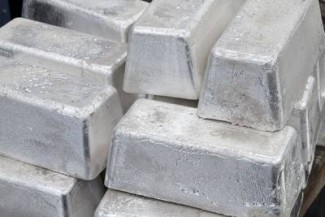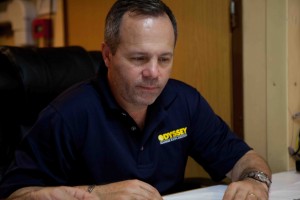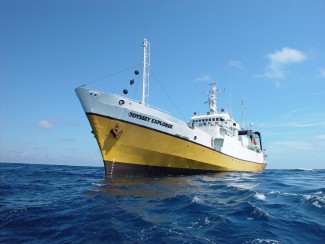‘SILVER RUSH’ INTERVIEW: Scouring the deep ocean for millions in coins

Amid the blue expanse of the open ocean, there are reportedly 3 million shipwrecks waiting to be found, waiting to be claimed. The maritime history of the world can be found in textbooks and archival records, but it also can be found on the sea floor, broken and barnacled, preserved in salt water.
Mark Gordon, president and COO of Odyssey Marine Exploration, said he has always loved this history, ever since growing up as a child in northern New Jersey and watching Jacques Cousteau documentaries. Today, he’s able to couple his interests with financial success, and the TV cameras are rolling to catch every minute of his adventures.
Odyssey Marine Exploration, subject of Discovery Channel’s upcoming Silver Rush miniseries, not only finds the shipwrecks at the bottom of the ocean, but also sends in equipment to retrieve the lucrative cargo holds of silver and other coins. When the team makes a haul from one of these wrecks, the earnings can be northward of $50 million.
It’s not exactly a 9-to-5 gig.
“It’s a lot like running any other publicly traded company, in terms of dealing with investors and you know our banks and the Securities and Exchange Commission,” Gordon said of his day-to-day responsibilities. “But it’s also very different because the nature of our business is we’re an exploration company, and there’s always something new and different happening.”
Gordon appears in a couple of the episodes of Silver Rush, which will air against the Oscar telecast Sunday, Feb. 24 at 8 p.m. He called his company’s relationship with Discovery a “great brand alignment.”
“They’re all about adventure and excitement and high technology, and that’s exactly what Odyssey is all about,” he said. “I think they portray the company in a favorable light. So, while it’s reality TV, it’s not the type of reality TV where people fight or get voted off the island.”

The attraction of a series like Silver Rush is that viewers can experience thrilling, deep-sea exploration from the safety of their living room. On the three-part special, there are three separate projects showcased. The one with the greatest promise of financial return is the SS Gairsoppa, which presents a unique challenge to Odyssey.
“The ship is 15,000 feet deep, almost 3 miles underwater, and that’s a mile deeper than the Titanic,” Gordon said. “So viewers will get to ride along and see if we were able to be successful.”
The life of an ocean explorer sounds romantically adventurous, but there can be downsides. As viewers watch Odyssey head for the Gairsoppa, there’s a sense of darkness overshadowing the efforts. That’s largely because the company was recently “forced to forfeit 17 tons of coins” worth hundreds of millions of dollars to the Spanish government. “So this was kind of a make-or-break season,” Gordon said. “We had an ‘all-in’ kind of bet going after these three projects simultaneously, and we ended up doing okay.”
Gordon spoke of the Spanish affair with a passing frustration. The complicated case, which included intervention by the U.S. government, left Odyssey with a decision that “doesn’t make a lot of sense.” The company retrieved the coins amid dangerous conditions, and yet the payday never happened as planned.
“It’s the first time in the history of admiralty law that a case has ever turned out that way,” he said. “Typically the salver would end up with 85 to 100 percent of the recovery, and the law interestingly dates back to Greek and Roman law. It was always set up … [to incentivize] entrepreneurs to take risk, to return value to the stream of commerce.”
Seventeen tons of coins later, that ancient law didn’t help much, even though the team worked through dangerous conditions to retrieve the buried treasure.

And those dangerous conditions can be difficult. Luckily for Odyssey, the company has a “stellar safety record,” Gordon said. “For instance, one of the things we decided early on is we don’t use manned submarines; we use unmanned submarines. They’re robots that are flown from the surface. So it’s a very dangerous environment being 3,000 miles out in the ocean just in the North Atlantic alone, but we’ve got the top professionals in the industry and a real eye on safety. … There are certainly mishaps out there, but more often, you know, it’s the risk of losing a multi-million dollar piece of equipment, not a human life.”
The dangerous environment and potential for mishaps were present when Odyssey sought out the Gairsoppa, a vessel with potentially up to 200 tons of coins. The first haul from the ship resulted in a financial tally of more than $40 million. If the company continues with the project, there could be another $50 million to $150 million left in the cargo.
It’s all in a day’s work for Gordon and his team.
“We have over 8,000 shipwrecks in our database, and at least a hundred of them were worth more than $50 million,” he said. “So there’s no question that there’s a lot of valuable and interesting things lying on the sea floor.”
The process of finding these ships filled with silver and other coins is a complicated one. Odyssey’s team of historians research the archives and track the expected site of the wrecked vessels. Ownership rights to the ship are secured, and the historians usually produce a search map of 300 square miles. From there, it’s the marine operations team that takes over and begins looking with high-tech equipment.
“We went out to look for the Gairsoppa, that’s the wreck primarily featured in this Discovery show,” he said. “People have looked for that wreck since 1941 when it was sunk by a U-boat. Our team found it in 22 days, and then because we had a 60-day lease on the search ship we were using, we called back to our research team and asked them to give us another target. They did. That’s the Mantola, which is another ship that’s featured in this Discovery show. And we found that one in 20 days. So that’s how the process works.”
Gordon said the company aims for the highest standard and follows all maritime rules and regulations. Odyssey focuses its efforts on commercial vessels that often date back to the colonial era. As far as deep-ocean archaeology goes, Odyssey has no real competition. Wrecks in shallow water can pique the interest of some companies, but when going miles under the surface, there’s no room for amateurs.
And it takes money to make money in this specialized industry. “With $50 [million] to $100 million you could buy yourself a nice starter kit,” Gordon said of the technology needed. “There are plenty of wrecks out there. The United Nations estimates 3 million shipwrecks on the sea floor. So a little competition wouldn’t be a bad thing, but it just doesn’t exist in deep ocean and marine archaeology right now.”
For Gordon, the Discovery Channel series and the recent successes for Odyssey prove to be a capstone to a career that began all the way back at the Jersey Shore, where he used to snorkel as a child. “I’m living my childhood dream,” Gordon said. “I wrote a business plan for this back in 1980, but didn’t have the capital to execute on it. I did four other companies prior to joining Odyssey … So got here a different way than I originally envisioned, but I’m here living my childhood dream.”
By John Soltes / Publisher / John@HollywoodSoapbox.com
-
Silver Rush premieres on Discovery Channel Sunday, Feb. 23 at 8 p.m.


I look forward to being able to view the series here in the U.K. sometime.
We followed the real life drama over the Spanish frigate Nuestra Señora de las Mercedes, and the Spanish government’s shameless legal action to win back treasure which probably would never have been recovered without Odyssey.
The Spanish diplomatic pressure on the U.S. government to bend the outcome was deplorable.
In the past, I have had conversations with Keith Jessop of Jessop Marine, who recovered over 400 gold bars from the Edinburgh. His book Goldfinder is worth reading.